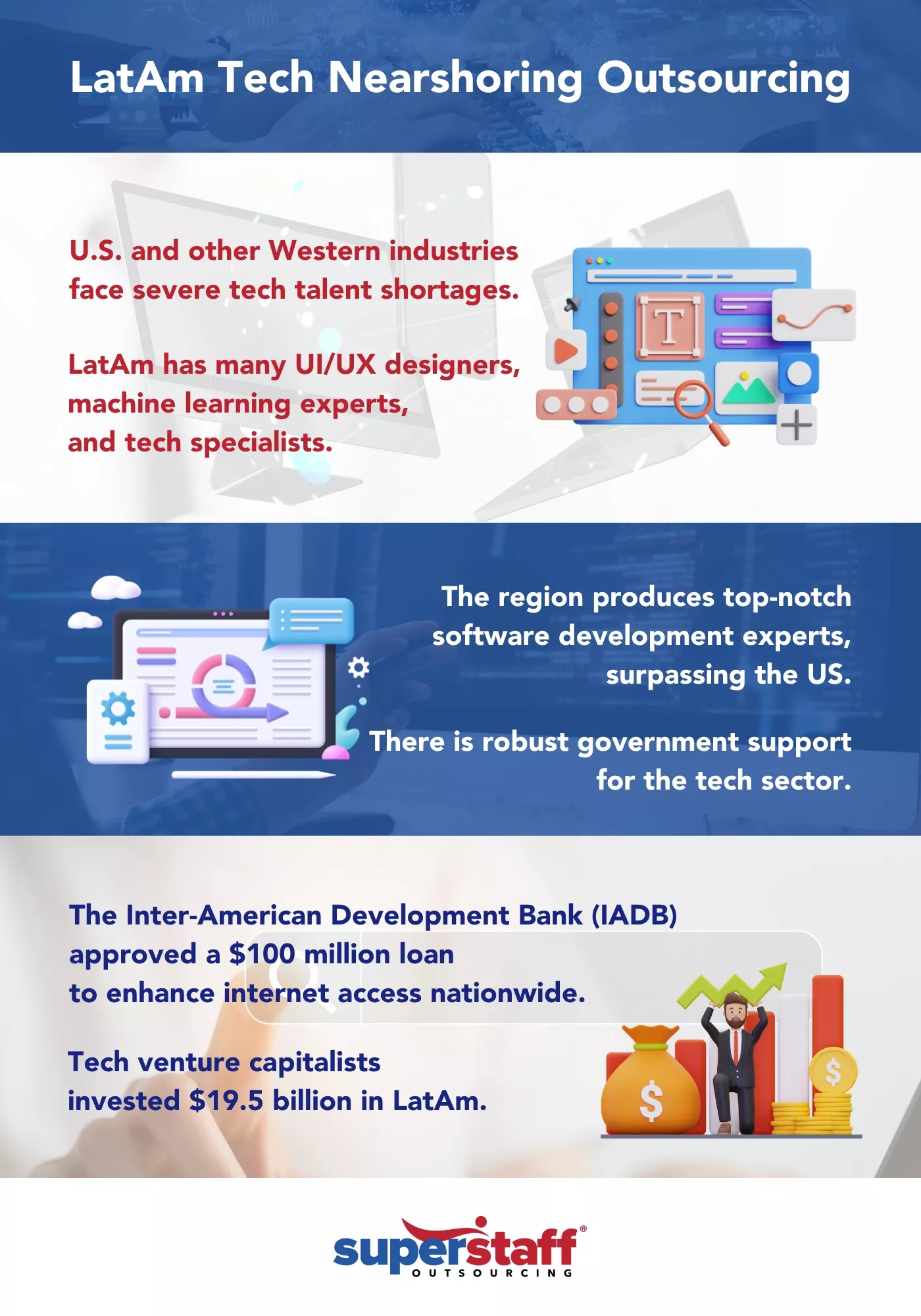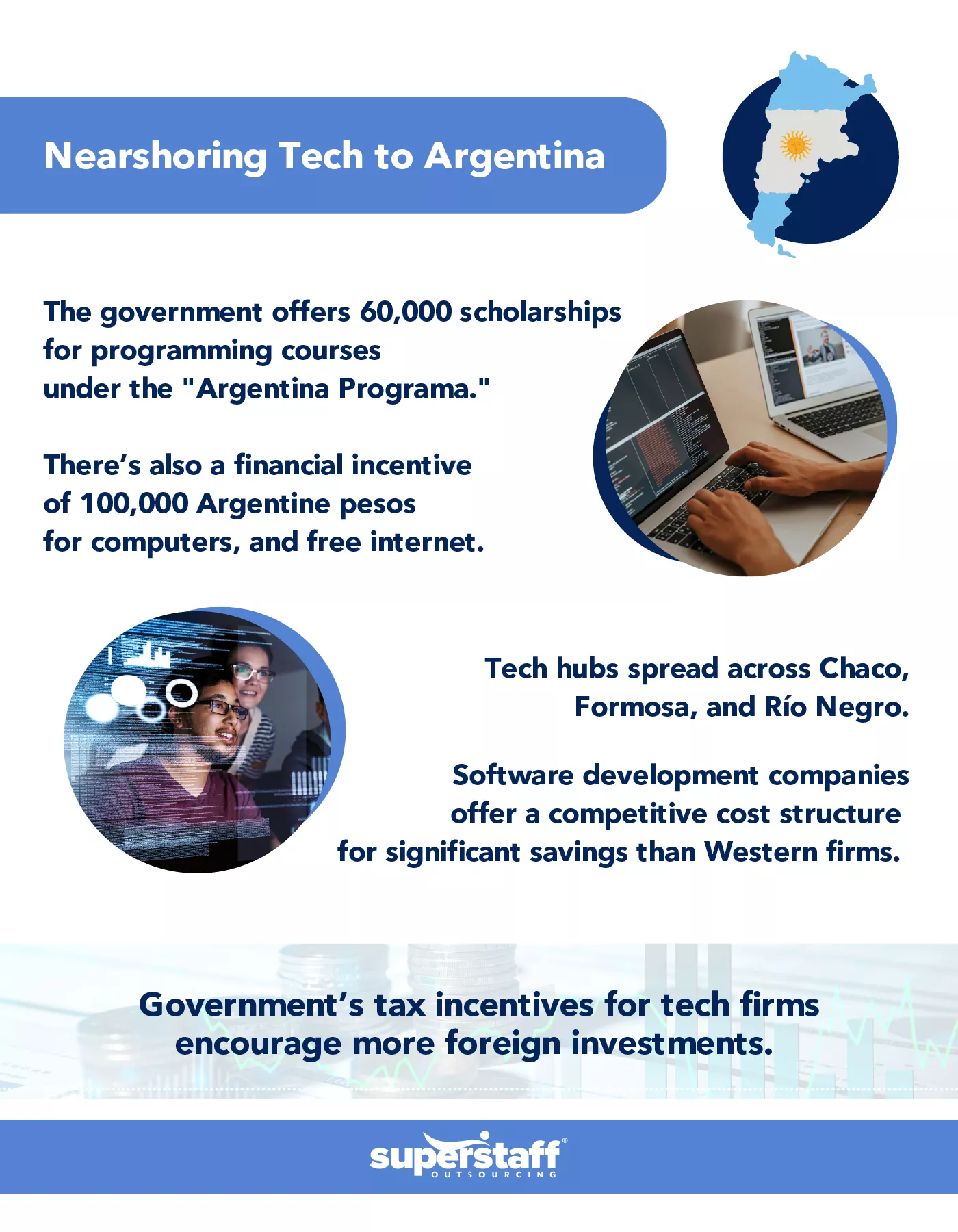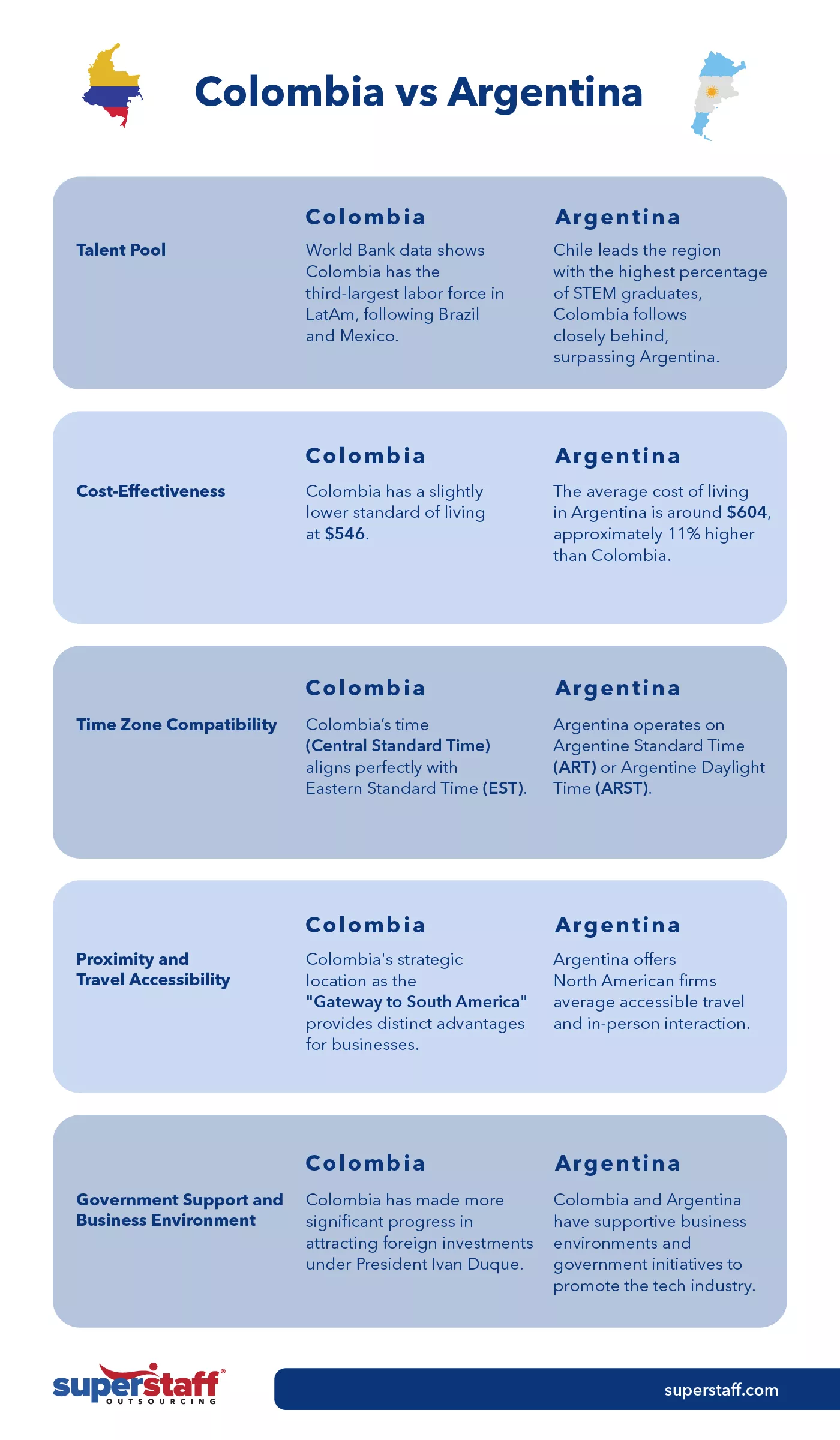
As the demand for tech talent surges, more firms turn to nearshore software outsourcing companies south of the border to fill the growing talent gap.
From Medellin in Colombia to Buenos Aires in Argentina, Latin America is making a name for itself as an up-and-coming tech hub. Google, IBM, and Dell are just a few big names in the laundry list of tech firms that have recognized the potential of this burgeoning “Silicon Valley.”
But while each LatAm country brings unique advantages that make it an ideal outsourcing destination, only one can emerge as the top tech nearshoring spot in the region. In this blog, we’re taking a deep dive into Colombia vs. Argentina for nearshore tech outsourcing to determine which country deserves the highly sought-after title “Silicon Valley of LatAm.”
Why Do Businesses Opt for Nearshore Outsourcing Tech Services to LatAm?

-
Labor Shortage
While technology plays a pivotal role in driving innovation, the industry faces a severe talent shortage that poses significant risks to all businesses that rely on tech.
Finding and recruiting skilled professionals, such as UI/UX designers, machine learning experts, and tech specialists, remains one of the biggest hurdles for senior executives. However, while tech firms in the US and other Western markets grapple with this challenge, LatAm has many specialized tech experts capable of taking on complex projects, propelling the region as a fast-emerging outsourcing destination.
-
Tech Education
LatAm countries’ emphasis on tech education is one of the key reasons behind the success of nearshoring in the region.
With significant investments in education and technology-focused programs, LatAm countries have nurtured a large pool of highly skilled engineers, developers, and IT professionals. These initiatives are already paying off, with LatAm countries like Mexico surpassing the US in terms of tech graduates.
As the region continues to produce top-notch software development experts, LatAm is poised to drive tech innovation and meet the global demand for tech workers amid the talent crunch.
-
Strong Government Support
Strong government support for the tech sector is another compelling factor driving international businesses to outsource in the region.
Governments in the region understand the power of digital transformation and are actively working to bridge the digital divide. The Inter-American Development Bank (IADB) in Argentina serves as a great example, having recently approved a substantial $100 million loan to enhance internet access throughout the country, particularly in remote areas traditionally underserved.
However, these government initiatives go beyond mere connectivity. They also encompass investments in digital training programs and certifications, intending to promote digital inclusion. By laying the groundwork for accessibility, governments are creating pathways for individuals to explore career opportunities in the tech sector.
-
Robust Funding
The region’s ability to secure robust funding for tech also fuels LatAm nearshoring.
The numbers speak for themselves. In the past year alone, Crunchbase data reveals that venture capitalists invested a whopping $19.5 billion in LatAm, far exceeding the record-high from the previous year.
The substantial increase in venture capital investment in the region reflects growing confidence in the region’s tech potential as more investors recognize the remarkable opportunities in LatAm’s tech landscape. With more capital, LatAm companies can hire top talent, invest in research and development, and expand their operations domestically and internationally.
Colombia vs. Argentina for Nearshore Technology Outsourcing: Which Is the True “Silicon Valley of LatAm?”
Now that we’ve learned about tech nearshoring in the region, let’s zoom in on two fast-emerging markets that have each staked a claim as the “Silicon Valley of LatAm.”
While Colombia and Argentina have made significant strides in positioning themselves as major tech hubs, each country offers unique advantages that firms can leverage to drive growth and innovation.
Want to learn more about the benefits of nearshoring in the region? Let’s dive in and find out which destination takes the LatAm nearshoring crown!
Advantages of Nearshoring Tech to Argentina

Skilled Workforce
Substantial investments in education, infrastructure, and government initiatives have solidified Argentina’s reputation as a prime nearshoring destination.
Moreover, the Argentine government recently launched “Argentina Programa” (Argentina Codes), a national initiative to further enhance the nation’s technical capabilities. It offers 60,000 scholarships for programming courses, a financial incentive of 100,000 Argentine pesos to purchase computers, and free internet connectivity.
Growing Tech Ecosystem
Tech has a powerful presence in Buenos Aires. However, numerous technological parks, hubs, and clusters exist across the country.
These hubs are spread across Chaco, Formosa, and Río Negro. Initially established as non-profits in the 2000s, these hubs offer various services, such as providing business opportunities and financing to local companies, organizing networking events for investors and entrepreneurs, offering training and professional internships, and providing coworking spaces for rent.
Competitive Cost Advantage
While Argentina is not necessarily the most cost-efficient outsourcing destination, nearshore software development companies still offer a competitive cost structure that allows companies significant savings compared to Western markets.
The country’s relatively lower standard of living also fuels savings as businesses won’t be compelled to spend massive amounts on equipment, office space, and other expenses that often drive up overhead costs.
Government Support and Stability
Due to the crucial role played by the tech sector in the Argentinian economy, its government has implemented a wide range of policies to foster the industry’s growth and development.
One notable measure is the implementation of tax incentives tailored explicitly for the industry. These incentives reduce the tax burden on tech firms, allowing them to allocate more resources toward research and development, hiring skilled professionals, and expanding their operations.
By offering tax incentives, the government aims to create a favorable business environment that encourages the growth and competitiveness of the tech sector.
Argentina also has established programs providing financial support and access to resources for tech startups and companies looking to develop a presence there. By actively encouraging foreign investment, the government seeks to leverage external expertise and capital to stimulate the industry’s growth and promote innovation.
Advantages of Nearshoring Tech to Colombia

Cost-Effectiveness
Due to its competitive labor cost, nearshoring to Colombia is a strategic, cost-efficient option for tech firms looking to optimize their operational costs.
To put this cost advantage into perspective, let’s consider the salary comparisons between the US and Colombia, specifically for software engineers. In the US, the average annual salary for a software engineer is around $114,000 as of 2022. Senior-level tech positions in the US could even command salaries as high as $181,444. Meanwhile, in Colombia, the typical annual wage for software engineers is $26,400.
This stark contrast illustrates the potential for substantial cost savings through Colombian nearshoring. By leveraging the lower labor costs in the country, businesses can access a talented pool of tech professionals without incurring the high expenses associated with hiring and maintaining an in-house team in local markets.
However, it is also important to note that this cost advantage doesn’t come at the expense of quality. The tech workforce in the country is highly skilled and competent, often having advanced technical expertise and proficiency in various programming languages and technologies.
Skilled, Educated, Bilingual Workforce
Colombia also boasts a robust education system that consistently produces many skilled professionals in various tech fields. The country is home to several reputable universities and technical institutes prioritizing technology-related programs, ensuring a steady supply of well-trained individuals for the talent pipeline.
Colombian IT professionals are known for their software development, web design, cybersecurity, and data analytics expertise. They acquire the necessary knowledge and skills through extensive education and training to excel in these specialized fields, making them valuable assets for tech firms seeking talent.
Colombia also stands out in the region for its abundant qualified labor. The 2022 IMD World Talent Report ranked the country third regarding available skilled workforce, surpassing Argentina, Brazil, and Chile.
Colombian workers are also bilingual, having learned Spanish and English in their primary education curriculum. English proficiency is exceptionally high in urban areas and among tech professionals. In fact, English is considered to be among the official languages in a few parts of the country, including the San Andrés and Santa Catalina Islands.
Proximity and Time Zone Compatibility
Colombia’s strategic geographical location also adds to its appeal as an outsourcing destination, particularly for companies based in North America.
The overlap in time zones means that business hours align more closely. The minimal time zone difference translates to seamless coordination and faster response times, essential for collaboration between nearshore companies and their clients.
Colombia’s proximity to North America also offers the advantage of quick, hassle-free travel for on-site visits. If you are traveling from Miami in Florida, you can easily hop on a 3.5-hour flight to Medellin, a key city in Colombia, and if you’re coming from New York, it’s a quick 4.5-hour flight.
This seamlessly allows face-to-face meetings, on-site training, and project management, enhancing collaboration and fostering a closer working relationship between the client and their outsourcing partners.
Government Support and Investment Incentives
The Colombian government demonstrates a proactive approach to promoting the growth and development of the tech industry while actively attracting foreign investment.
To incentivize foreign direct investment, the government has established regulations and frameworks that offer enticing benefits to international companies, such as creating free trade zones for foreign investors. These zones provide favorable business conditions, including non-taxable goods and deductible research and development taxes, significantly reducing operational costs.
In addition to these incentives, the Colombian government prioritizes improving technology and infrastructure to support foreign investment. The country boasts the highest number of cables in the LatAm region, ensuring optimal connectivity and high-speed transmission for smooth data transfer, communication, and collaboration between international teams.
Speed-to-Market Advantage
Speed is of utmost importance in this hypercompetitive market.
Fortunately, Colombia’s advantageous location can help boost US business’ speed to market.
From a logistical standpoint, Colombia’s geographical proximity to the US and its well-connected port infrastructure means that companies can reduce transit times, minimize supply chain disruptions, and overcome cross-border trade issues.
Stable Economy
Colombia’s strong and resilient economy is another critical factor in the success of Colombian nearshoring. As the fourth largest IT market in the region, Colombia has established itself as a thriving hub for software and IT services, with a market value exceeding $8.2 billion.
Despite the challenges posed by the pandemic, the Colombian economy has shown resilience and is projected to experience robust growth. In 2022, it was anticipated to rise by 5.5%, demonstrating the country’s ability to rebound and recover. The economy is expected to maintain a positive trajectory with a projected growth rate of 3.1% throughout 2023.
Colombia’s expanding IT market signifies demand for tech solutions and services, creating ample opportunities for businesses to provide expertise and meet market needs.
Growing Tech Ecosystem
Colombia has experienced remarkable growth in its tech ecosystem, establishing itself as a thriving hub for innovation, tech startups, and entrepreneurship.
The collaborative nature of Colombia’s tech ecosystem enables startups, established companies, and aspiring entrepreneurs to network, share experiences, and leverage each other’s strengths for success.

For a broader perspective, let’s compare the two countries and discover why Colombia has bagged the top spot in the Offshore BPO Confidence Index for two consecutive years.
Talent Pool
Colombia boasts a much larger talent pool than Argentina, making it an attractive destination for companies looking to outsource services. According to data from the World Bank, Colombia has the third-largest labor force in LatAm, following Brazil and Mexico.
While Chile leads the region with the highest percentage of STEM (science, technology, engineering, and mathematics) graduates, Colombia follows closely behind, surpassing Argentina – which reflects the country’s focus on cultivating a workforce skilled in tech.
Cost-Effectiveness
While Colombia and Argentina offer competitive cost advantages, Colombia tends to have a slightly lower standard of living.
The cost of living is an important consideration when assessing outsourcing destinations, and in this regard, Colombia takes the lead over Argentina. The average cost of living in Argentina is around $604, approximately 11% higher than the average cost of living in Colombia, estimated at $546.
Since the overall cost of living influences employee salaries and overhead costs, this can directly impact a tech firm’s bottom line.
Time Zone Compatibility
Without daylight savings, Colombia’s time (Central Standard Time) aligns perfectly with Eastern Standard Time (EST).
This time zone synchronicity allows for real-time collaboration and communication while reducing potential misunderstandings and ensuring smoother workflow and interactions.
On the other hand, Argentina operates on Argentine Standard Time (ART) or Argentine Daylight Time (ARST), which may not align as closely with all regions in the US. The time difference between Argentina and the US can range from one to three hours – depending on the specific location within the US – which could potentially create challenges in terms of scheduling and communication between teams.
Proximity and Travel Accessibility
Colombia’s strategic location as the “Gateway to South America” provides distinct advantages for businesses, particularly those based in North America. It allows for more accessible travel and in-person interaction compared to outsourcing destinations further away, such as Argentina.
Companies in North America can benefit from more frequent site visits, whether it’s for initial onboarding, project kick-offs, progress reviews, or meetings with nearshore software development teams.
Government Support and Business Environment
Colombia and Argentina have supportive business environments and government initiatives to promote the tech industry. However, Colombia has made more significant progress in attracting foreign investment and fostering innovation.
Under the leadership of former President Ivan Duque, the government made progressive policies aimed at fostering industry growth. Programs like “Colombia Bring IT On” have positioned Colombia as an emerging tech hub, offering additional support and incentives to tech companies.
Why Colombia Takes the Crown: Colombia vs Argentina for Nearshore Tech Outsourcing
When it comes to LatAm nearshore software development services, Colombia stands out as a frontrunner for many reasons. From the abundance of local tech talent to the country’s thriving tech ecosystem, it’s no wonder why so many businesses are entrusting their tech operations and business processes to nearshore outsourcing companies.
Partner with a reliable Colombian nearshoring BPO. SuperStaff has a nearshoring site in Medellin, Colombia’s biggest and most established tech hub. Contact us today to maximize your business growth and take advantage of our complete IT and tech solutions suite!






